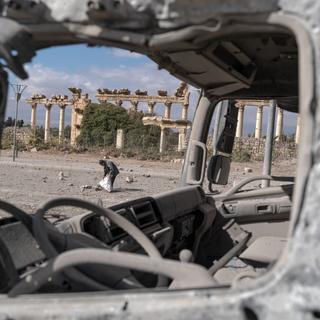


Israeli bombardment threatens Lebanon's architectural heritage
NewsIn Baalbek, strikes hit the immediate vicinity of rich Roman remains and damaged churches. Other ancient sites in Tyre and Byblos are under threat. UNESCO's Special Committee for the Protection of Cultural Property in the Event of Armed Conflict will hold a special session devoted to Lebanon on November 18.
"I'm so sad for our city. They're no longer content to target people. It's now our history and heritage that are in danger." Mohamed Awada, deputy mayor in charge of tourism and heritage for the city of Baalbek, is distraught. The 150,000 visitors who used to flock to the city's 1,000-year-old sites every summer are now a distant memory. The city's temples, some of the most imposing remains of Roman architecture at its height, stand watch over a city at war and suffering. On November 6, dozens of inhabitants were killed by a series of Israeli strikes, one of which hit the immediate vicinity of the acropolis.

A grayish dust covers the parking lot, the carcasses of charred vehicles and licks the columns of Bustan al-Khan, the odeon that marks the entrance to a 2,000-year-old site. All that remains of the stone Menchiye building with its arabesque arcades, built in 1928 in Ottoman style, is a pile of rubble. It was here, at around 7 pm, that an Israeli missile landed 50 meters from the perimeter of the UNESCO World Heritage Site. The blast also blew out windows and parts of the façade of the Palmyra Hotel, opened in 1874, which offers a spectacular view of the temples of Bacchus and Jupiter, the city's two jewels.
Two churches, one Maronite and one Orthodox, Saydet Al-Maounet and Mar Gerios, nestled next to each other in front of the temple entrance, suffered damage to their roofs, woodwork and windows. Some 20 families, most of them Shiite, who had taken refuge there since September 23, fled the premises. Only Abu George, the desperate janitor of the two churches, remained. "Look at the windows, the state of the tiles, the cracks... Why do this to us?" he said, still dazed. He remembers cowering against a wall at the moment of the strike, stunned, as the panicked cries of refugees filled the place of worship. Across the street, all the façades show varying degrees of damage in a city dotted with collapsed buildings.
'It's a crime'
"It's a world heritage site. We can't let a place like this be bombed," said Awada, the deputy mayor. "Whatever the reasons, or under the pretext of the presence of one or two members of Hezbollah. It's a question of proportionality, it's a crime. There are no missile ramps here. Every time they target one person, they kill whole families. It's also a message: We strike where we want and we don't care about your lives or your heritage."


Like Baalbek, other ancient UNESCO World Heritage cities such as Byblos and Tyre are threatened by Israeli strikes. In Tyre, an ancient Phoenician city with important Roman and medieval Crusader remains, bombing raids have targeted buildings some 200 meters from the Roman ruins. An entire wall of the Toron citadel, a fortress built in the 12th century, at the time of the Crusades, in Tebnine, near Bint Jbeil, in southern Lebanon, was destroyed at the end of October by Israeli strikes.
You have 59.72% of this article left to read. The rest is for subscribers only.
